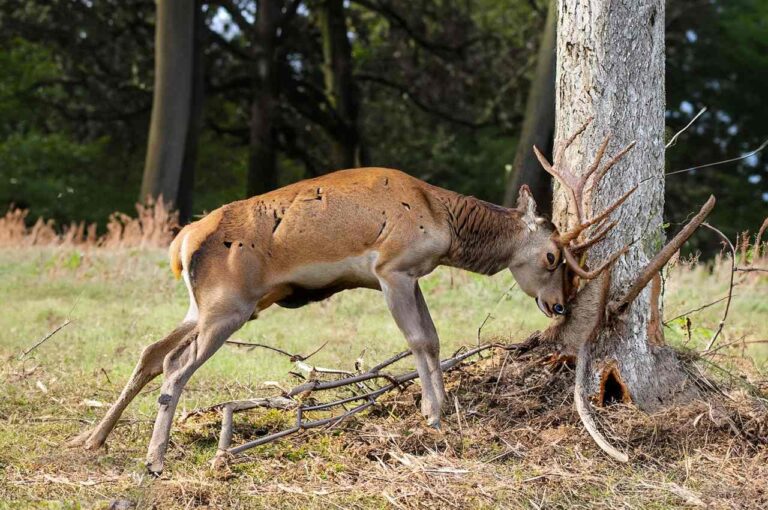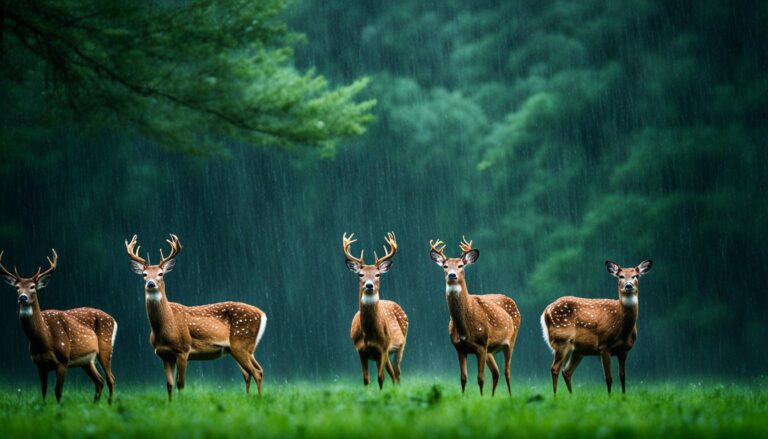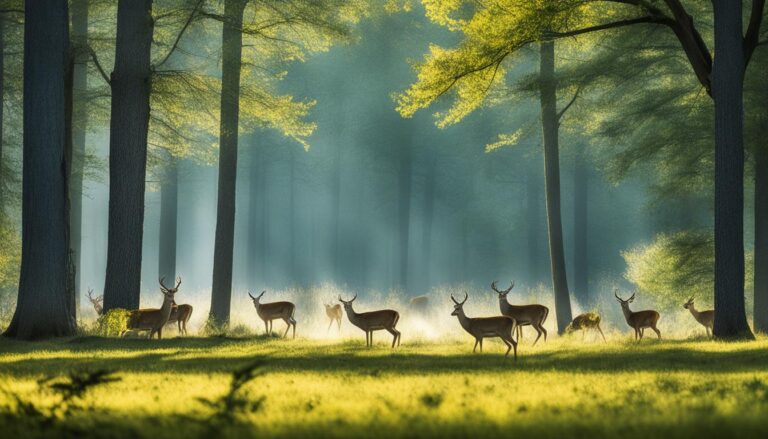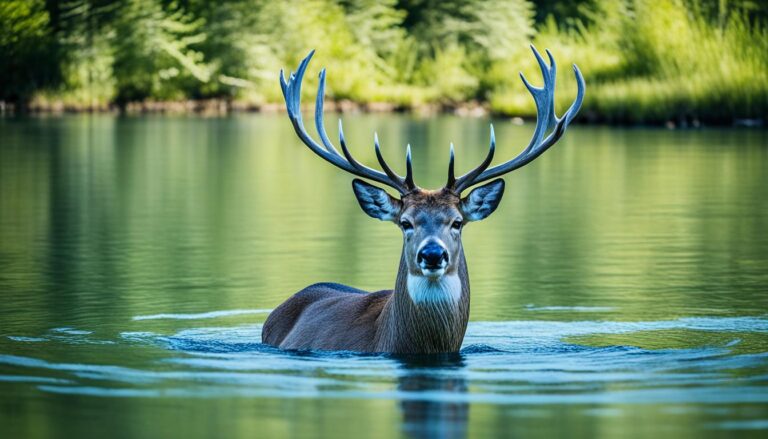Do Deer Hibernate? Uncover the Truth About Deer
Deer, unlike some mammals, do not hibernate during the winter. However, they have fascinating adaptations that allow them to survive in harsh winter conditions. Let’s explore the hibernation habits of deer and discover how they endure the cold months.
Content Highlights
ToggleKey Takeaways:
- Deer do not hibernate like some mammals.
- They rely on strategic feeding habits in the fall to store fat as an energy source.
- Deer have a thick winter coat that insulates them against the cold.
- They voluntarily reduce their activity during late winter to conserve energy.
- Deer have evolved to adapt and survive extreme winter conditions.
Deer Winter Behavior and Sheltering
During winter, deer exhibit various behaviors to cope with the harsh conditions and ensure their survival. Understanding their winter behavior and sheltering habits can provide valuable insights into how these magnificent creatures adapt to the cold and protect themselves from the elements.
Deer seek shelter in areas that provide protection from the weather. In regions with south-facing hardwood slopes, they gravitate towards these locations as the slopes help shield them from strong winds. Additionally, deer are known to establish traditional “deer yards” in more northern climates. These deer yards are often found in mature conifer stands with dense canopies that provide excellent insulation against the cold and snow. Remarkably, multiple generations of deer may utilize the same deer yard, highlighting the significance of such sheltering spots for their survival.
During stormy winter weather, deer minimize their activity and movement. They choose to seek cover in heavily wooded areas, near dense bushes, or even in hollowed-out trees. These natural hiding places provide additional protection from the elements, buffering the deer from harsh winds, snow, and rain. By reducing their activity, deer can conserve valuable energy and rely on their stored fat reserves to sustain them during times of food scarcity.
“Winter is a challenging time for wildlife, and deer are no exception. They employ remarkable strategies to find shelter and stay warm during the cold months.” – Wildlife Conservationist
Deer also adjust their metabolism to conserve energy during winter. As the days grow shorter and food becomes scarce, deer lower their metabolic rates, allowing them to use their stored fat reserves more efficiently. This adaptation helps them endure extended periods without substantial food sources, enabling them to survive the winter months.
By understanding and appreciating the winter behavior and sheltering habits of deer, we can gain a deeper insight into their remarkable ability to adapt and thrive in challenging environments.
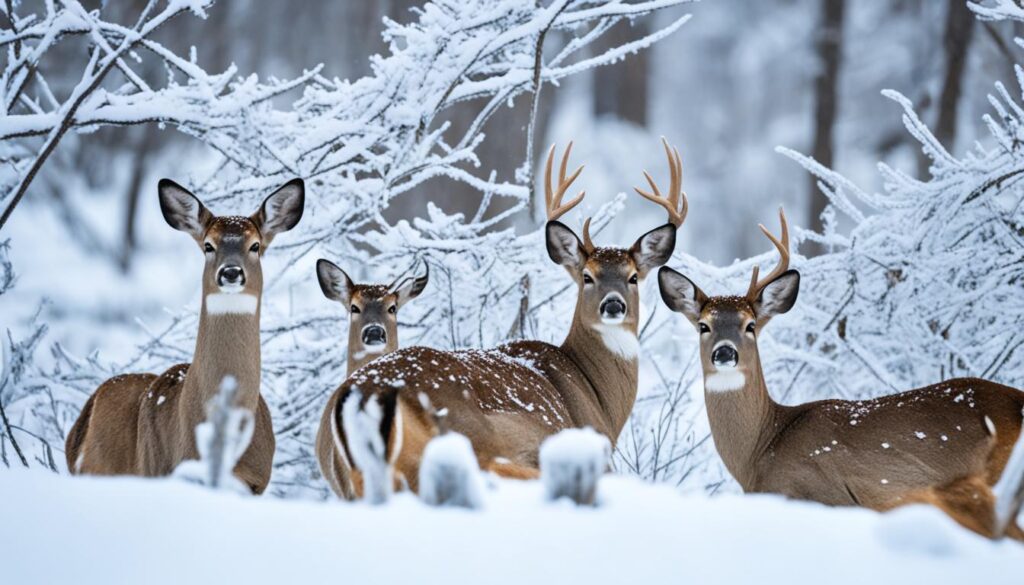
Deer Sleep Patterns
While deer don’t experience traditional sleep patterns like humans, they do exhibit restful periods throughout the day. Deer are crepuscular animals, meaning they are most active during the twilight hours of dawn and dusk. During the day, they often find sheltered areas, such as dense brush or forests, to rest and conserve energy. These resting periods allow deer to remain vigilant and alert to potential threats while still achieving a state of relaxation and restfulness.
Where Do Deer Go in Winter?
During winter, deer seek shelter in areas that provide protection from the harsh weather conditions. They utilize south-facing hardwood slopes, traditional deer yards in coniferous forests, and heavily wooded areas near dense bushes or hollowed-out trees. These locations provide adequate cover from strong winds, snow, and rain, ensuring the deer’s survival in winter.
| Deer Winter Behavior and Sheltering | |
|---|---|
| Behavior | Details |
| Seeking Shelter | Deer search for areas offering protection from weather conditions and gravitate towards south-facing hardwood slopes or traditional deer yards in more northern climates. |
| Reduced Activity | During stormy winter weather, deer reduce their activity and movement, seeking cover in heavily wooded areas, near dense bushes, or even in hollowed-out trees. |
| Metabolic Adjustments | Deer lower their metabolism to conserve energy during winter, allowing them to rely on stored fat reserves when food is scarce. |
Deer Winter Diet and Adaptations
During winter, deer face the challenge of food scarcity, but they have developed remarkable adaptations to survive in these harsh conditions. Let’s explore the ways in which deer adapt their diet and physiology to endure the cold.
Adapting their Diet: In the winter months, deer primarily rely on their preferred winter forages, which include shoots of woody browse, select conifer species, and persistent fruits or leaves. However, when these food sources become scarce, deer will eat whatever they can to sustain themselves. This includes harder and more fibrous foods like pinecones, barks, twigs, nuts, and even corn if available.
Seeking Shelter and Conserving Energy: To survive the cold weather, deer actively seek out areas with cover that provide shelter from the elements. These areas help protect them from extreme winds and heavy snowfall. Additionally, deer focus on conserving energy during winter by reducing their activities and movement. By doing so, they maximize their energy stores and increase their chances of survival.
Physiological Adaptations: Deer have also evolved various physiological adaptations to thrive in cold weather. They grow a thick winter coat that provides insulation and helps them retain body heat. Their lowered metabolism enables them to conserve energy, while the decreased heart rate helps them utilize their fat reserves efficiently. These adaptations allow deer to withstand the harsh winter conditions.
The Importance of Winter Adaptations
Understanding how deer adapt their diet and physiology in winter is crucial for appreciating their resilience and survival strategies. Let’s take a closer look at their dietary adaptations with the help of a table:
| Winter Food Sources | Adaptations |
|---|---|
| Shoots of woody browse | Preferable source of nutrition |
| Select conifer species | Provides sustenance and browse |
| Persistent fruits or leaves | Supplemental food sources |
| Pinecones, barks, twigs, nuts | Consumed when other food is scarce |
| Corn | Alternative food source if accessible |
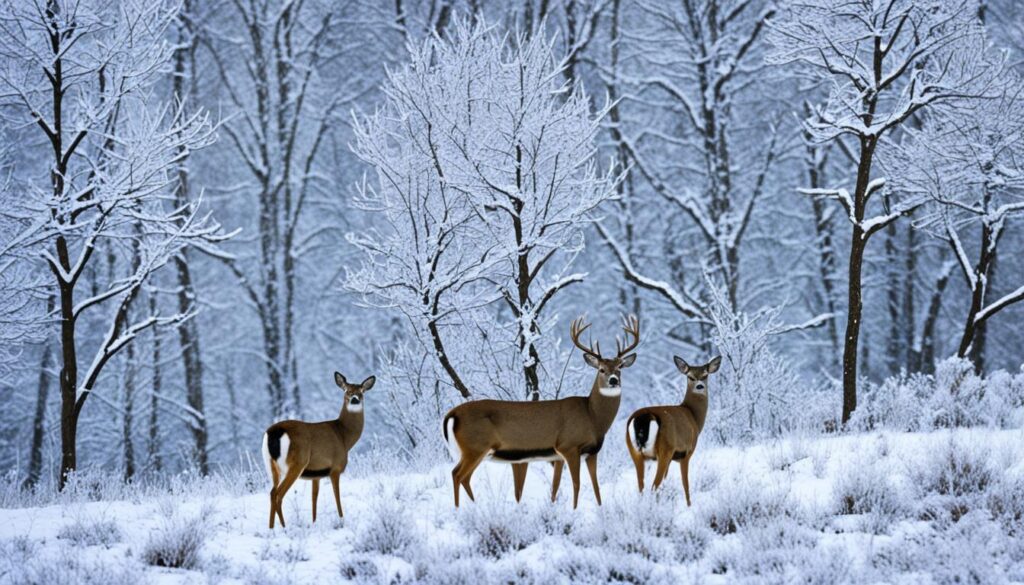
As shown in the table above, deer exhibit dietary flexibility by adjusting their preferences and consuming a variety of foods to survive during winter. Their ability to adapt their diet and utilize available resources is a vital part of their winter survival.
Conclusion
In conclusion, deer do not hibernate in winter. Instead, they have developed remarkable survival strategies to endure the harsh conditions. Strategic feeding habits and fat reserves play a crucial role in their winter survival. Additionally, deer have adaptations like a thick winter coat and lower metabolism that help them conserve energy.
Seeking shelter in areas that provide protection from the weather is another important behavior of deer during winter. Whether it’s south-facing hardwood slopes or traditional deer yards in more northern climates, these locations offer the necessary refuge. By reducing their activity and movement during stormy weather, deer can further conserve energy and avoid unnecessary exposure to the elements.
While winter poses challenges for deer in terms of food scarcity, they adapt their diet to survive. Although their preferred winter forages include shoots of woody browse, select conifer species, and persistent fruits or leaves, deer will consume harder and more fibrous foods when necessary. Their ability to utilize whatever food sources are available showcases their resourcefulness in the face of adversity.
Understanding and respecting the winter habits of deer is crucial to their survival. By providing appropriate food sources and maintaining suitable habitat, we can contribute to their well-being. Let us appreciate these magnificent creatures and the incredible ways they have adapted to prevail in winter’s challenging conditions.
- Wyoming Deer Season 2025-2026 New Schedule & Rules - 15 September 2025
- Wisconsin Deer Season 2025-2026: WI Deer Hunting Guide [Schedule, Rules, Licenses] - 15 September 2025
- West Virginia Deer Season 2025-2026 Complete Date & Guide - 15 September 2025


